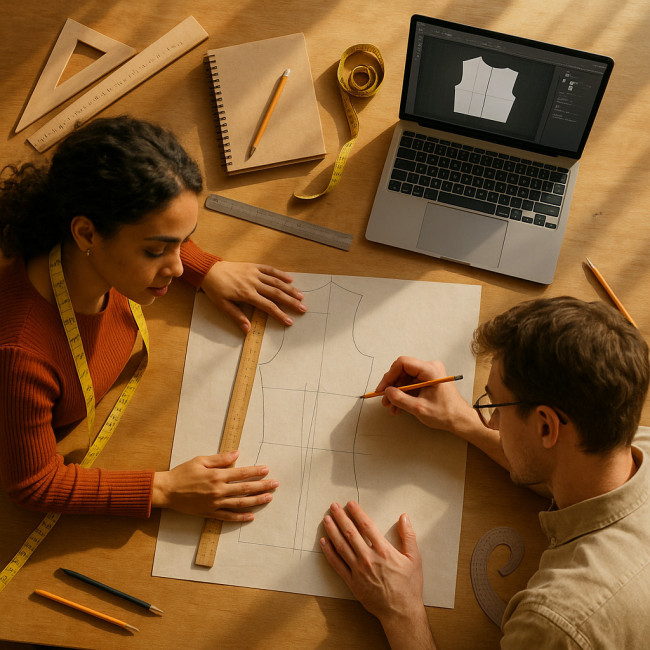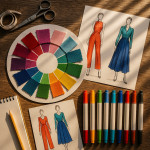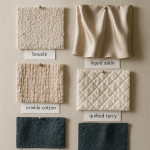Free pattern-making resources: a skill roadmap for emerging clothing designers
Want to turn sketches into production-ready garments without paying four-figure tuition fees? This roadmap lists the best free pattern-making resources, orders them by skill level and shows you how to combine them with practice so you advance from zero to confident sampler in under six months.
Why pattern-making is the gateway skill you cannot skip
Production managers, factory owners and experienced seamstresses all speak the language of blocks, darts and grainlines. When you understand pattern-making, you:
- Translate creative silhouettes into technical specs that factories respect.
- Slash prototype costs by spotting fit issues on paper before the first muslin.
- Open revenue streams such as digital patterns for home sewers or limited-edition DIY kits.
In short, pattern mastery lifts your credibility at every stage—from crowdfunding to inclusive sizing, as explored in our inclusive sizing guide.
Roadmap: five learning stages and the resources that power each one
Stage 1 – Vocabulary & tool setup (Week 1-2)
- OpenFashion Glossary PDF – 120 terms with sketches. Free download, no sign-up.
- “Pattern Tools on a Budget” YouTube playlist by MadeToSew (9 videos, 75 min total).
- Community thread: r/sewing “Starter Toolkits” sticky post—crowd-vetted lists for under €50.
Stage 2 – Drafting basic blocks (Week 3-6)
- Great British Sewing Bee Bodice Block – BBC file pack includes measurement guide.
- Victoria & Albert Museum's online course extract: “Flat-pattern 101” (2 hours of video).
- Free trial of Valentina (open-source software) for digital drafting.
Practice tip: Draft one block on paper and the same block in Valentina. Comparing the two highlights scale errors fast.
Stage 3 – Fit corrections & toile testing (Week 7-10)
- Fashion Incubator tutorial series: “Diagnosing Drag Lines” (downloadable PDF + photos).
- University of Fashion free lesson: “Pivoting Darts for Perfect Bust Fit.”
- OpenFit Google Sheet – crowd-sourced fit issue database searchable by body measurement.
Stage 4 – Style adaptations & trend translation (Week 11-16)
- Pattern Lab London blog: 20 free hacks that turn a bodice block into 2024 silhouettes.
- FibreMood's free pattern add-ons released each quarter.
- Pair lessons with trend-forecasting tools to ensure your new styles match upcoming textures and palettes.
Stage 5 – Production files & grading (Week 17-24)
- Inkscape plug-in “Ink/Stitch” – free grading function and export to layered PDF.
- Spoonflower's spec sheet templates (A0 and US Letter) with bleed and seam allowances built in.
- Open Apparel Registry – verify size labels align with global factories' expectations.
Once you grade three sizes, share them in forums like FashionWorkroom for peer review. This public critique often reveals factory-blocking mistakes you missed.
Comparing resource types: choose what fits your learning style
| Resource type | Strength | Weakness | Best for stage |
|---|---|---|---|
| PDF e-books | Offline access; printable | Few motion visuals | 1, 2 |
| YouTube playlists | Real-time demos | Ads & pacing issues | 2, 3 |
| Open-source software | Scales instantly; easy duplication | Steeper setup curve | 2, 5 |
| Online forums | Peer feedback | Quality varies | 3, 5 |
| Museum archives | Historic accuracy | Limited modern sizing | 4 |
Integrate practice loops to cement every milestone
Passive watching is not enough. After each resource, run a three-step loop:
- Apply – Draft or amend one pattern immediately.
- Document – Photograph pattern pieces and note time spent.
- Reflect – Post results for critique or measure against a store sample.
Designers who track loops in a simple spreadsheet cut their learning curve by up to 30 % according to Open Fashion Survey 2023.
Beyond the pattern table: leverage community accountability

Working in isolation often slows growth because mistakes hide in plain sight, unchallenged by fresh eyes. By intentionally stepping into a community—whether a live video room, a local maker space or a well-moderated forum—you create a feedback loop that exposes fitting issues, celebrates micro-victories and keeps motivation high. Commit to sharing at least one in-progress pattern photo every week, respond constructively to two peers and track the themes that emerge. Over a six-month span, this simple accountability rhythm can multiply your improvement rate, curb perfectionism and spark collaborations that evolve into joint capsule collections or bulk-buy fabric deals.
Sign up for monthly “open studio hours” on the Artfolio Clothing-Designers Training Hub. You can share screens, get real-time pinning advice and network with sourcing specialists—a perfect complement to the freelance qualification checklist you may already follow.
Funding your first test batch after free learning
Once your graded pattern earns five positive fit reviews, consider launching a micro-run through preorders or crowdfunding. Early sales validate both your design and your self-taught technical chops.
Common pitfalls and how to avoid them
- Relying on one body form – always test patterns on at least two size extremes.
- Skipping seam-allowance checks – free blocks often omit them; add before printing.
- Mismatched printing scales – verify the 10 cm test square every time you download a new PDF.
Quick self-assessment quiz
FAQ
- Are free pattern blocks reliable enough for commercial production?
- Yes—if you validate them with muslin tests, fit sessions on varied bodies and digital checks for grainline accuracy. Many indie brands launch first runs using refined free blocks.
- How long does it take to master basic pattern-making with free resources?
- Following the roadmap above, most learners reach sample-ready competence in four to six months of part-time study (5–7 hours/week).
- Do I need paid CAD software after this roadmap?
- No. Open-source tools such as Valentina and Ink/Stitch cover drafting, grading and export. You can always migrate to paid solutions once order volumes justify the cost.
Take action now: pick one Stage 1 resource, block two hours in your calendar and draft your first bodice block tonight. Momentum starts with the very first line you draw.











